DynDSE: Automated Multi-Objective Design Space Exploration for Context-Adaptive Wearable IoT Edge Devices
Abstract
1. Introduction
- We present a simulation-based Design Space Exploration (DynDSE) procedure for wearable IoT devices that employ context-adaptive pattern recognition algorithms for event retrieval, see Figure 1. We provide a formal characterisation of the design space, given a set of system functionalities, components, and their parameters. An iterative search evaluates configurations according to system requirements. The inherent trade-off embedded in conflicting objectives are explored to find an optimal configuration.
- We perform a wearable IoT application evaluation to analyse the resource-performance trade-off considering static and dynamic design aspects through simulations with actual data of Electromyography (EMG)-monitoring eyeglasses in automated dietary monitoring.
2. Related Work
3. Exploration Framework
3.1. Design Space Representation
3.2. Configuration Generation
3.3. Configuration Evaluation
4. Optimisation Metrics
4.1. Retrieval Performance Metric
4.2. Execution Time Metric
4.3. Energy Consumption Metric
4.4. Memory Demand Metric
4.5. Communication Latency Metric
5. IoT Application Evaluation
5.1. Smart Eyeglasses to Monitor Eating in Free-Living
5.2. Design Space Representation
5.2.1. Algorithm ()
5.2.2. Data Sampling ()
5.2.3. C ()
5.2.4. Runtime mode ()
5.3. Configuration Evaluation
5.3.1. Sensor Dataset
5.3.2. Multi-Objective Computation
- Kernel SVM:cycles, where , is the number of support vectors;
- Radial basis function:cycles.
5.3.3. Multi-Objective Visualisation
5.3.4. Multi-Objective Analysis
6. Discussion
7. Conclusions and Future Work
Author Contributions
Funding
Acknowledgements
Conflicts of Interest
Abbreviations
| C | Microcontroller |
| BLE | Bluetooth Low Energy |
| CL | Communication latency |
| DSE | Design space exploration |
| EC | Energy consumption |
| ECG | Electrocardiography |
| EEG | Electroencephalography |
| EMG | Electromyography |
| ET | Execution time |
| FFT | Fast Fourier transform |
| FPGA | Field Programmable Gate Array |
| GPU | Graphics Processing Unit |
| IoT | Internet of things |
| IP | Intellectual Property |
| LOPO | Leave-one-participant-out |
| MPS | Maximum payload size |
| ocSVM | One-class support vector machines |
| P | Precision |
| PCA | Principal component analysis |
| R | Recall |
| SVM | Support vector machines |
| WPD | Wavelet packet decomposition |
References
- Amft, O. How wearable computing is shaping digital health. IEEE Pervasive Comput. 2018, 17, 92–98. [Google Scholar] [CrossRef]
- Verma, P.; Sood, S.K. Fog assisted-IoT enabled patient health monitoring in smart homes. IEEE Internet Things J. 2018, 5, 1789–1796. [Google Scholar] [CrossRef]
- Tokognon, C.A.; Gao, B.; Tian, G.Y.; Yan, Y. Structural health monitoring framework based on Internet of Things: A survey. IEEE Internet Things J. 2017, 4, 619–635. [Google Scholar] [CrossRef]
- Sittón-Candanedo, I.; Alonso, R.S.; Corchado, J.M.; Rodríguez-González, S.; Casado-Vara, R. A review of edge computing reference architectures and a new global edge proposal. Future Gener. Comput. Syst. 2019, 99, 278–294. [Google Scholar]
- Selvaraj, S.; Sundaravaradhan, S. Challenges and opportunities in IoT healthcare systems: A systematic review. SN Appl. Sci. 2020, 2, 139. [Google Scholar] [CrossRef]
- Jayakumar, H.; Raha, A.; Kim, Y.; Sutar, S.; Lee, W.S.; Raghunathan, V. Energy-efficient system design for IoT devices. In Proceedings of the 2016 21st Asia and South Pacific Design Automation Conference (ASP-DAC), Macau, China, 25–28 January 2016; pp. 298–301. [Google Scholar]
- Belwal, M.; Sudarshan, T. A survey on design space exploration for heterogeneous multi-core. In Proceedings of the 2014 International Conference on Embedded Systems (ICES), Coimbatore, India, 3–5 July 2014; pp. 80–85. [Google Scholar]
- Pimentel, A.D. Exploring exploration: A tutorial introduction to embedded systems design space exploration. IEEE Des. Test 2016, 34, 77–90. [Google Scholar] [CrossRef]
- Schiboni, G.; Amft, O. Saving energy on wrist-mounted inertial sensors by motion-adaptive duty-cycling in free-living. In Proceedings of the 2018 IEEE 15th International Conference on Wearable and Implantable Body Sensor Networks (BSN), Las Vegas, NV, USA, 4–7 March 2018; pp. 197–200. [Google Scholar]
- Brandolese, C.; Fornaciari, W.; Pomante, L.; Salice, F.; Sciuto, D. Affinity-driven system design exploration for heterogeneous multiprocessor SoC. IEEE Trans. Comput. 2006, 55, 508–519. [Google Scholar]
- Streichert, T.; Glaß, M.; Haubelt, C.; Teich, J. Design space exploration of reliable networked embedded systems. J. Syst. Archit. 2007, 53, 751–763. [Google Scholar] [CrossRef]
- Haubelt, C.; Schlichter, T.; Keinert, J.; Meredith, M. SystemCoDesigner: Automatic design space exploration and rapid prototyping from behavioral models. In Proceedings of the 45th Annual Design Automation Conference. ACM, Anaheim, CA, USA, 8–13 June 2008; pp. 580–585. [Google Scholar]
- Bharatula, N.B.; Stäger, M.; Lukowicz, P.; Tröster, G. Empirical study of design choices in multi-sensor context recognition systems. In Proceedings of the IFAWC 2nd International Forum on Applied Wearable Computing, Zurich, Switzerland, 17–18 March 2005; pp. 79–93. [Google Scholar]
- Bharatula, N.B.; Anliker, U.; Lukowicz, P.; Tröster, G. Architectural tradeoffs in wearable systems. In Proceedings of the International Conference on Architecture of Computing Systems, Anaheim, CA, USA, 8–13 June 2008; pp. 217–231. [Google Scholar]
- Anliker, U.; Beutel, J.; Dyer, M.; Enzler, R.; Lukowicz, P.; Thiele, L.; Troster, G. A systematic approach to the design of distributed wearable systems. IEEE Trans. Comput. 2004, 53, 1017–1033. [Google Scholar]
- Anliker, U.; Junker, H.; Lukowicz, P.; Tröster, G. Design methodology for context-aware wearable sensor systems. In Proceedings of the International Conference on Pervasive Computing, Berlin, Germany, 8 May 2005; pp. 220–236. [Google Scholar]
- Beretta, I.; Rincon, F.; Khaled, N.; Grassi, P.R.; Rana, V.; Atienza, D.; Sciuto, D. Model-based design for wireless body sensor network nodes. In Proceedings of the 2012 13th Latin American Test Workshop (LATW), Quito, Ecuador, 10–13 April 2012; pp. 1–6. [Google Scholar]
- Stäger, M.; Lukowicz, P.; Tröster, G. Power and accuracy trade-offs in sound-based context recognition systems. Pervasive Mob. Comput. 2007, 3, 300–327. [Google Scholar]
- Rault, T.; Bouabdallah, A.; Challal, Y.; Marin, F. A survey of energy-efficient context recognition systems using wearable sensors for healthcare applications. Pervasive Mob. Comput. 2017, 37, 23–44. [Google Scholar] [CrossRef]
- Mesin, L. A neural algorithm for the non-uniform and adaptive sampling of biomedical data. Comput. Biol. Med. 2016, 71, 223–230. [Google Scholar] [CrossRef] [PubMed]
- Scarabottolo, I.; Alippi, C.; Roveri, M. A spectrum-based adaptive sampling algorithm for smart sensing. In Proceedings of the 2017 IEEE SmartWorld, Ubiquitous Intelligence & Computing, Advanced & Trusted Computed, Scalable Computing & Communications, Cloud & Big Data Computing, Internet of People and Smart City Innovation (SmartWorld/SCALCOM/UIC/ATC/CBDCom/IOP/SCI), San Francisco, CA, USA, 4–8 August 2017; pp. 1–8. [Google Scholar]
- Rieger, R.; Taylor, J.T. An adaptive sampling system for sensor nodes in body area networks. IEEE Trans. Neural Syst. Rehabil. Eng. 2009, 17, 183–189. [Google Scholar] [CrossRef] [PubMed]
- Künzli, S.; Thiele, L.; Zitzler, E. Modular design space exploration framework for embedded systems. IEEE Proc.-Comput. Digit. Tech. 2005, 152, 183–192. [Google Scholar] [CrossRef]
- Gajski, D.D.; Vahid, F.; Narayan, S.; Gong, J. System-level exploration with SpecSyn. In Proceedings of the 35th Annual Design Automation Conference, San Francisco, CA, USA, 15–19 June 1998; pp. 812–817. [Google Scholar]
- Zhuge, Q.; Shao, Z.; Xiao, B.; Sha, E.H.M. Design space minimization with timing and code size optimization for embedded DSP. In Proceedings of the 1st IEEE/ACM/IFIP International Conference on Hardware/Software Codesign and System Synthesis, Newport Beach, CA, USA, 1–3 October 2003; pp. 144–149. [Google Scholar]
- Rajagopal, S.; Cavallaro, J.R.; Rixner, S. Design space exploration for real-time embedded stream processors. IEEE Micro 2004, 24, 54–66. [Google Scholar] [CrossRef]
- Powers, D.M. Evaluation: From precision, recall and F-measure to ROC, informedness, markedness and correlation. Mach. Learn. Technol. 2011, 2, 37–63. [Google Scholar]
- Konstantakos, V.; Chatzigeorgiou, A.; Nikolaidis, S.; Laopoulos, T. Energy consumption estimation in embedded systems. IEEE Trans. Instrum. Meas. 2008, 57, 797–804. [Google Scholar] [CrossRef]
- Prayati, A.; Antonopoulos, C.; Stoyanova, T.; Koulamas, C.; Papadopoulos, G. A modeling approach on the TelosB WSN platform power consumption. J. Syst. Softw. 2010, 83, 1355–1363. [Google Scholar] [CrossRef]
- Zhang, R.; Amft, O. Monitoring chewing and eating in free-living using smart eyeglasses. IEEE J. Biomed. Health Inform. 2017, 22, 23–32. [Google Scholar] [CrossRef]
- Schiboni, G.; Amft, O. Automatic dietary monitoring using wearable accessories. In Seamless Healthcare Monitoring; Springer: Berlin/Heidelberg, Germany, 2018; pp. 369–412. [Google Scholar]
- Zhang, R.; Amft, O. Free-living eating event spotting using EMG-monitoring eyeglasses. In Proceedings of the 2018 IEEE EMBS International Conference on Biomedical & Health Informatics (BHI), Las Vegas, NV, USA, 4–7 March 2018; pp. 128–132. [Google Scholar]
- Chu, J.U.; Moon, I.; Lee, Y.J.; Kim, S.K.; Mun, M.S. A supervised feature-projection-based real-time EMG pattern recognition for multifunction myoelectric hand control. IEEE/ASME Trans. Mechatron. 2007, 12, 282–290. [Google Scholar] [CrossRef]
- Schiboni, G.; Suarez, J.C.; Zhang, R.; Amft, O. Attention-Based Adaptive Sampling for Continuous EMG Data Streams. In Proceedings of the 2019 IEEE SmartWorld, Ubiquitous Intelligence & Computing, Advanced & Trusted Computing, Scalable Computing & Communications, Cloud & Big Data Computing, Internet of People and Smart City Innovation (SmartWorld/SCALCOM/UIC/ATC/CBDCom/IOP/SCI), Leicester, UK, 19–23 August 2019; pp. 1178–1183. [Google Scholar]
- Buschhoff, M.; Günter, C.; Spinczyk, O. A unified approach for online and offline estimation of sensor platform energy consumption. In Proceedings of the 2012 8th International Wireless Communications and Mobile Computing Conference (IWCMC), Limassol, Cyprus, 27–31 August 2012; pp. 1154–1158. [Google Scholar]
- Mikhaylov, K. Simulation of network-level performance for Bluetooth Low Energy. In Proceedings of the 2014 IEEE 25th Annual International Symposium on Personal, Indoor, and Mobile Radio Communication (PIMRC), Washington, DC, USA, 2–5 September 2014; pp. 1259–1263. [Google Scholar]
- Zhang, R.; Bernhart, S.; Amft, O. Diet eyeglasses: Recognising food chewing using EMG and smart eyeglasses. In Proceedings of the 2016 IEEE 13th International Conference on Wearable and Implantable Body Sensor Networks (BSN), San Francisco, CA, USA, 14–17 June 2016; pp. 7–12. [Google Scholar]
- Azariadi, D.; Tsoutsouras, V.; Xydis, S.; Soudris, D. ECG signal analysis and arrhythmia detection on IoT wearable medical devices. In Proceedings of the 2016 5th International Conference on Modern Circuits and Systems Technologies (MOCAST), Thessaloniki, Greece, 12–14 May 2016; pp. 1–4. [Google Scholar]
- Kumar, G.S.A.; Manimaran, G.; Wang, Z. End-to-end energy management in networked real-time embedded systems. IEEE Trans. Parallel Distrib. Syst. 2008, 19, 1498–1510. [Google Scholar] [CrossRef]
- Shoaib, M.; Jha, N.K.; Verma, N. Algorithm-driven architectural design space exploration of domain-specific medical-sensor processors. IEEE Trans. Very Large Scale Integr. VLSI Syst. 2012, 21, 1849–1862. [Google Scholar] [CrossRef]
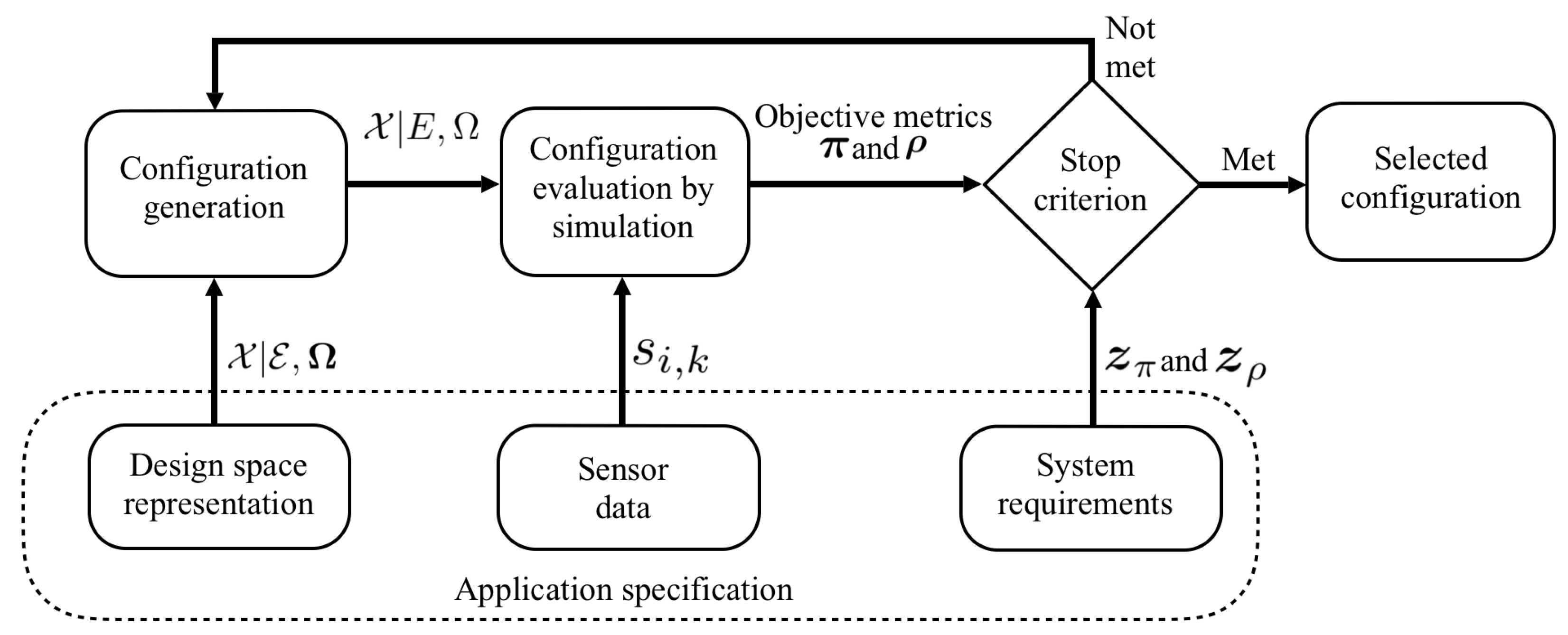
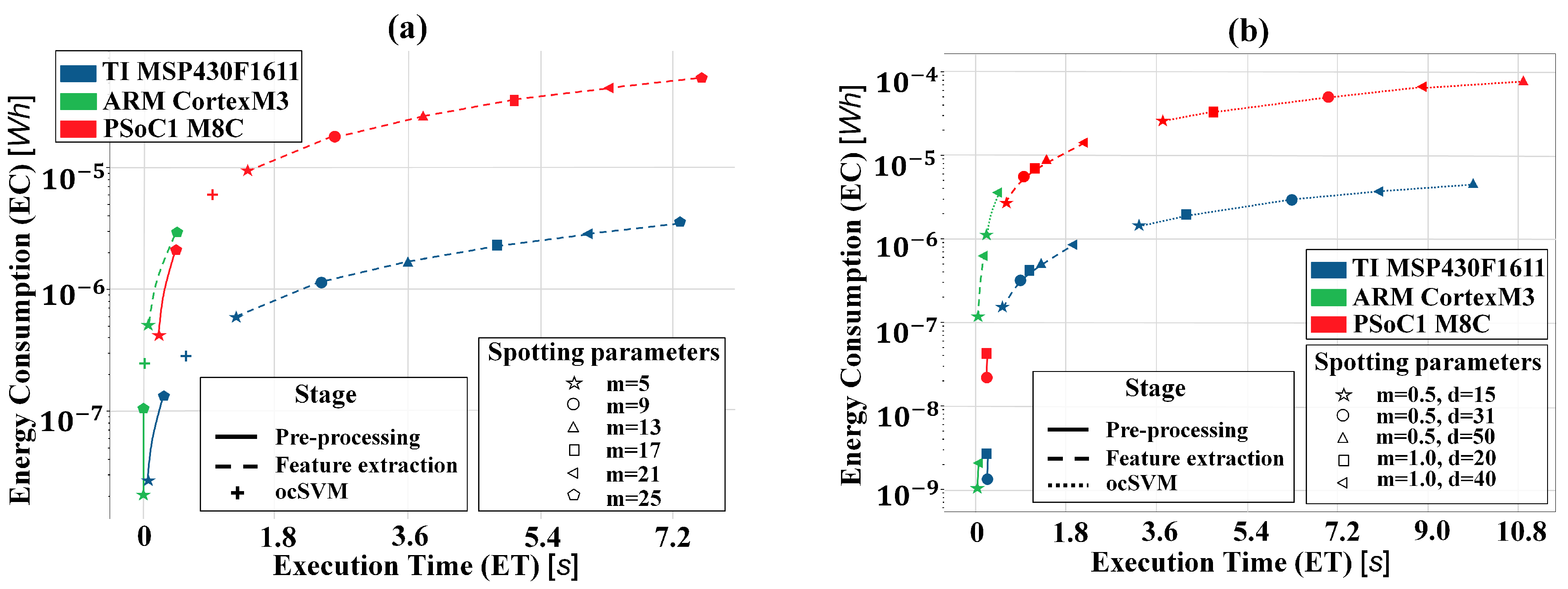
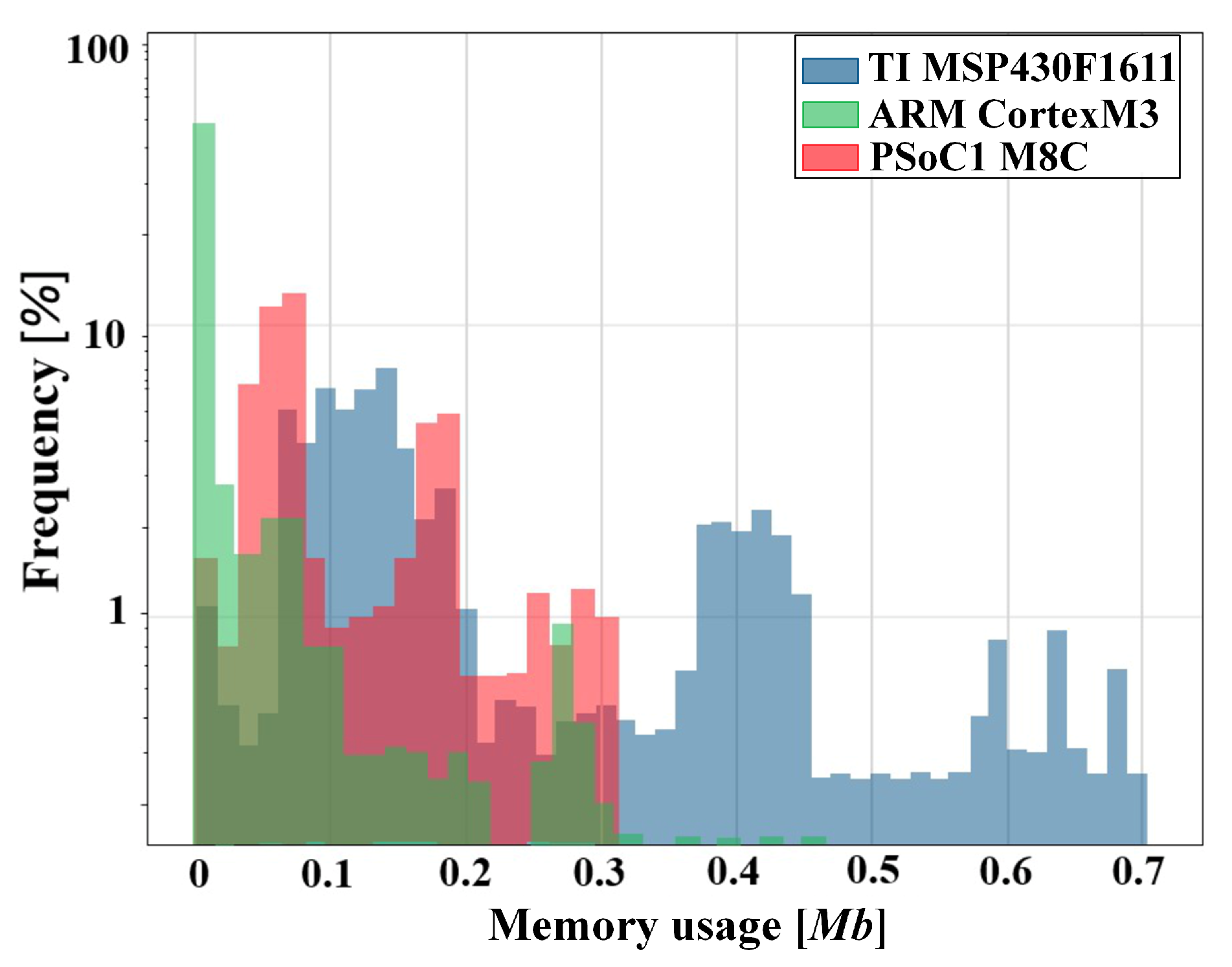
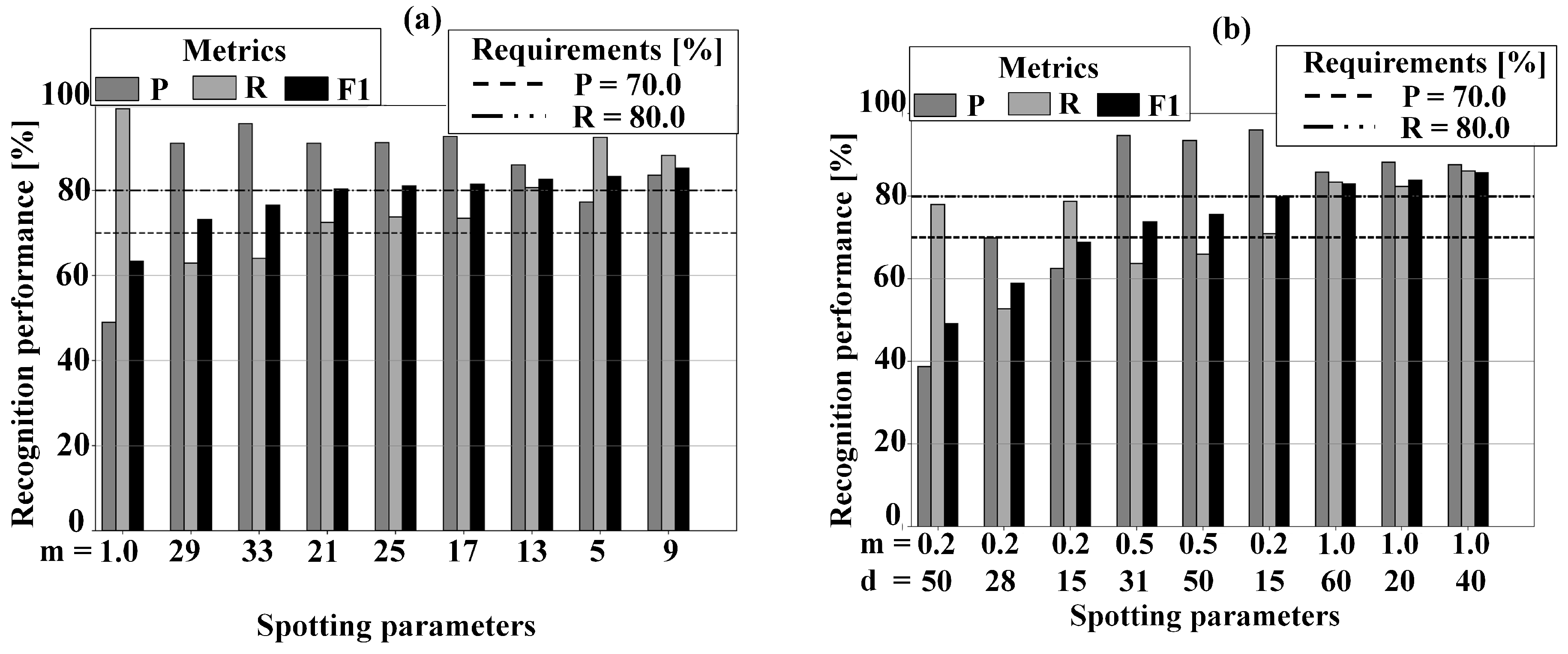
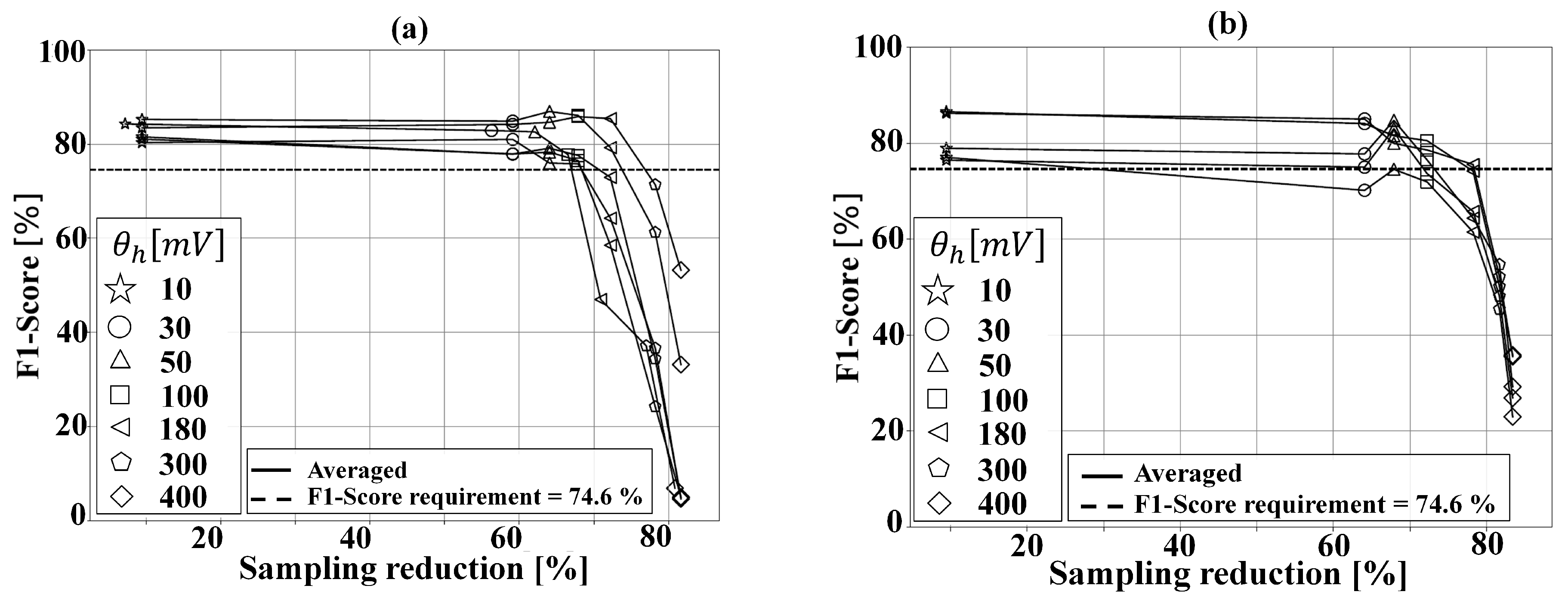
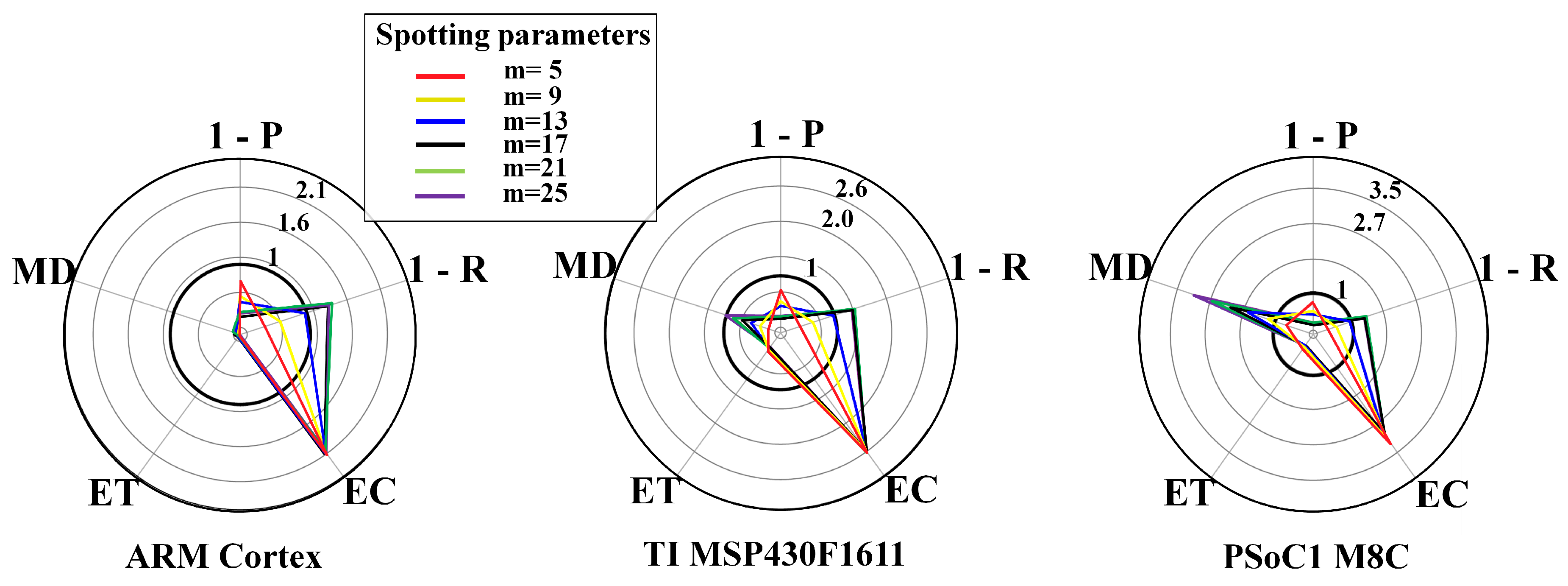
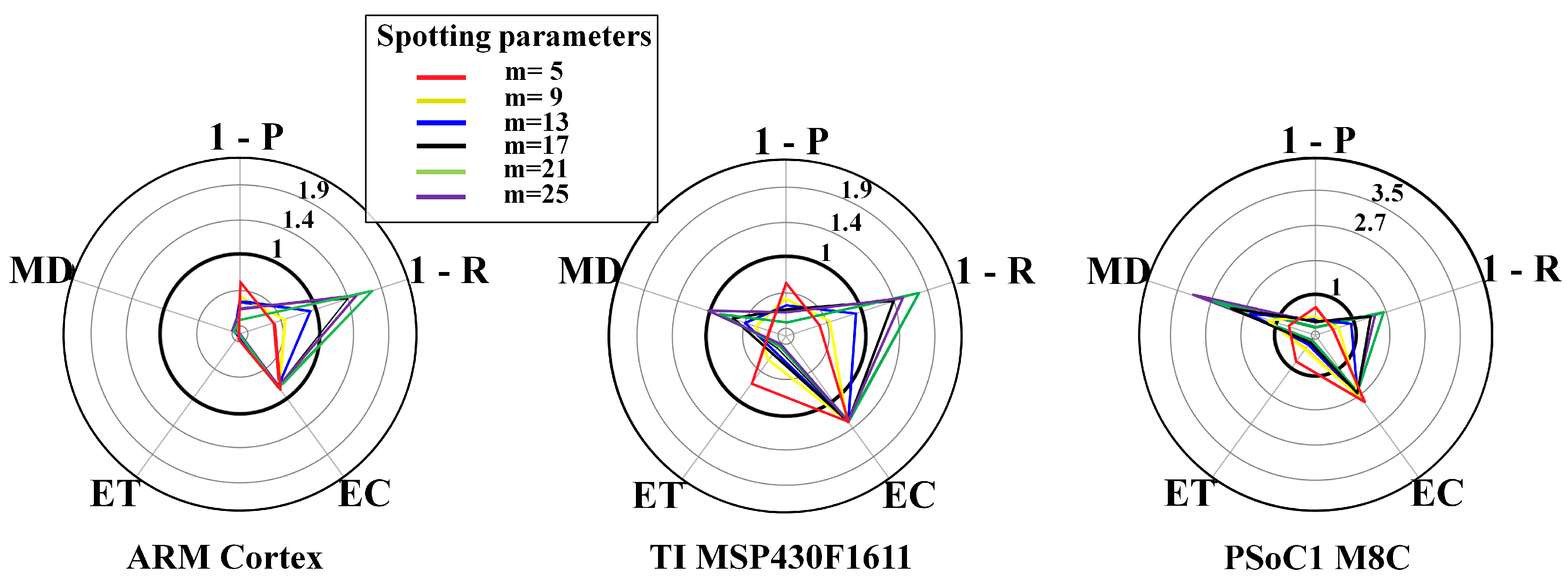
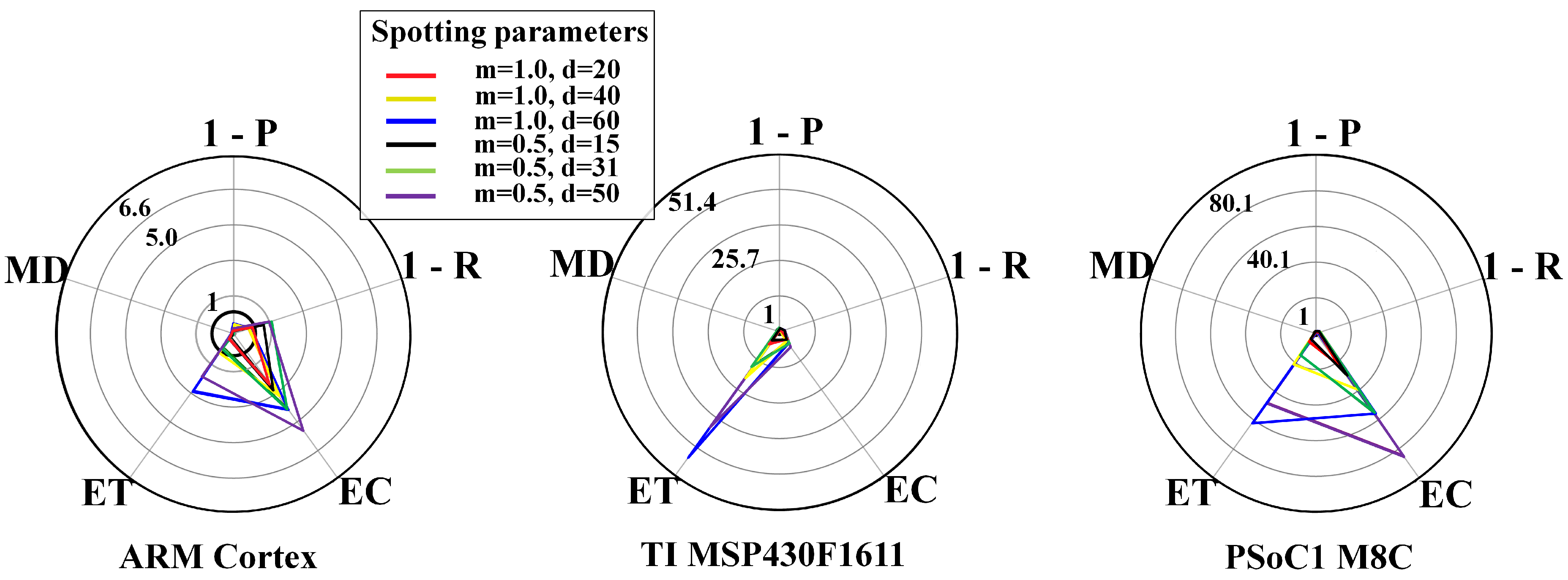
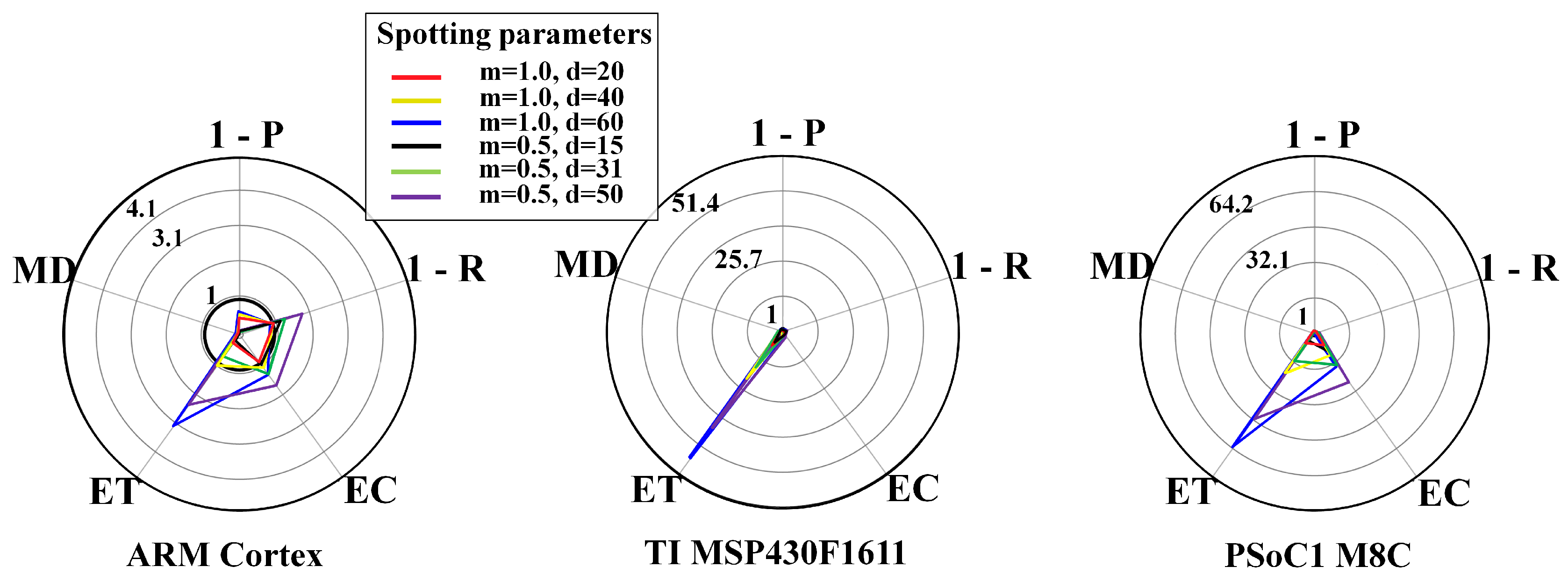
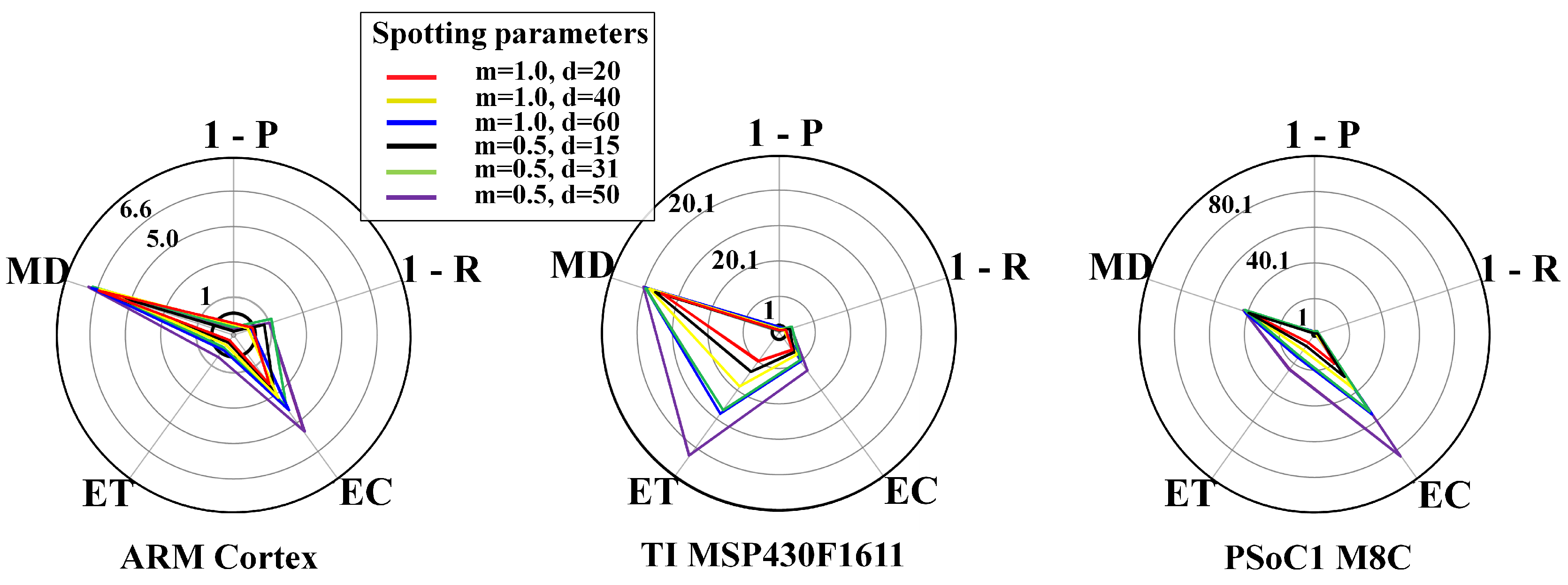
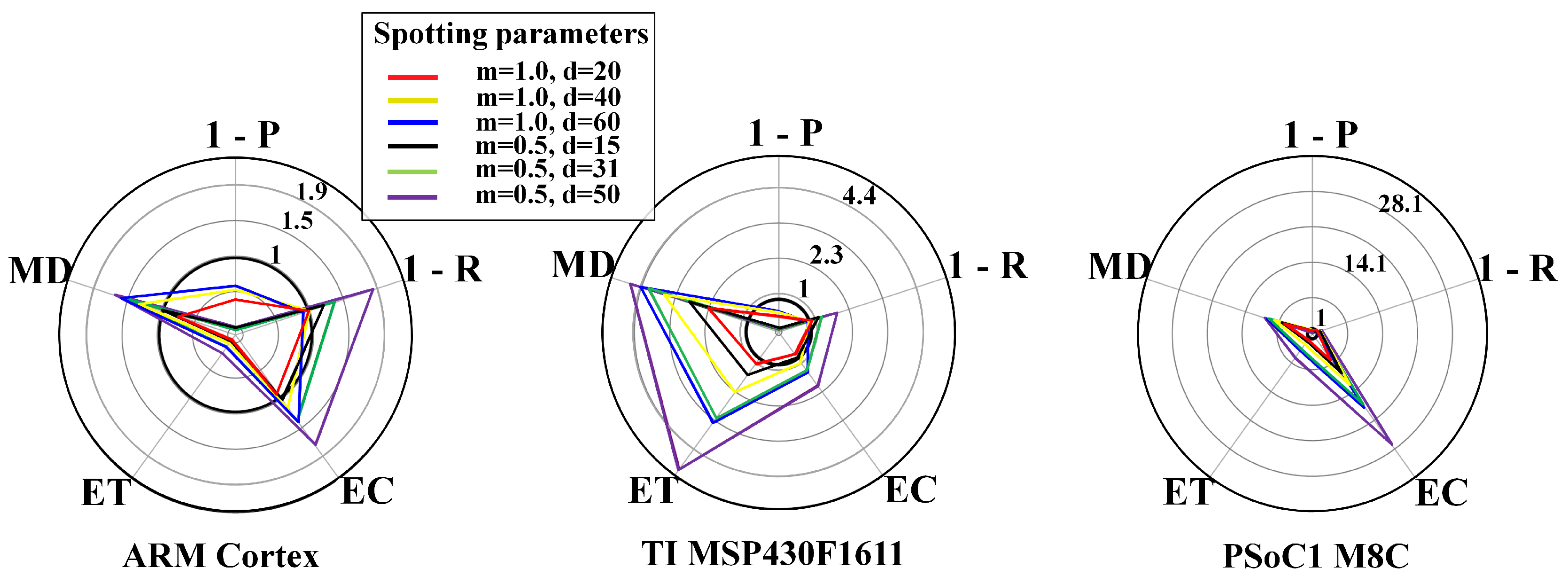

| The Requirement Is Imposed by | |||||||||
|---|---|---|---|---|---|---|---|---|---|
| Objective | Abbreviation | Description | Requirement | Value | Task | Battery life | |||
| P | Precision | , | X | ||||||
| R | Recall | X | |||||||
| ET | Ex. time in real-time | Real-time: | X | X | |||||
| Ex. time online | Online: | X | X | ||||||
| EC | Energy Consumption | X | X | ||||||
| MD | Memory Demand | Variable (see Table 5) | X | ||||||
| Functionality () | Algorithm () | Data Sampling () | Microcontroller () | Runtime Mode () |
|---|---|---|---|---|
| Component () | FFT-based () | Uniform () | PSoC1 M8C () | Real time () |
| WPD-based () | Adaptive () | TI MSP430F1611 () | Online () | |
| ARM CortexM3 () | ||||
| Parameter () | Data frame size m () | |||
| Data frame size m () | Context measure’s upper bound () | |||
| Dim. feature space d () |
| Algorithm | Stage | Function | N. Arithmetical Operations | Memory Demand | |||||||
|---|---|---|---|---|---|---|---|---|---|---|---|
| Add | Mult | Div | Root | Comp | Exp | Integers | Floats | ||||
| Both | Pre-processing | Low-pass filtering | m | - | - | - | - | - | - | 1 | |
| FFT-based | Feature extraction | Standard deviation | m | 2 | 1 | - | - | 1 | - | ||
| Fast Fourier trasform | - | - | - | - | - | k | |||||
| Maximum | - | - | - | - | - | 1 | - | ||||
| L2-norm | d | - | 1 | - | - | 1 | - | ||||
| WPD-based | Feature extraction | WPD | - | - | - | - | - | ||||
| PCA | - | - | - | - | - | ||||||
| L2-norm | d | - | 1 | - | - | 1 | - | ||||
| Both | Spotting | Kernel SVM | - | - | 1 | - | v | ||||
| + Radial basis kernel | - | - | 1 | v | - | 1 | |||||
| Function | N. Arithmetical Operations | Memory Demand | ||||||
|---|---|---|---|---|---|---|---|---|
| Add | Mult | Div | Root | Comp | Exp | Integers | Floats | |
| Context measure | - | 2 | - | - | - | 1 | ||
| Response output | 4 | 1 | 1 | - | - | - | - | 4 |
| Attention time | - | - | - | - | 2 | - | - | 2 |
| Number of Machine Cycles per Operation | Memory spec. | |||||||||
|---|---|---|---|---|---|---|---|---|---|---|
| ROM/ Flash | RAM | |||||||||
| PSoC1 M8C | 544 | 560 | 912 | 1344 | 80 | 2672 | 32 | 2 | ||
| TI MSP430F1611 | 177 | 153 | 405 | 668 | 37 | 334 | 48.25 | 10 | ||
| ARM CortexM3 | 60 | 50 | 80 | 380 | 12 | 210 | 512 | 96 | ||
| Functionality | Component | Electric Characteristics | ||||||||
|---|---|---|---|---|---|---|---|---|---|---|
| Memory Write Operation | ||||||||||
| V | Res. | Cap. | [Byte] | |||||||
| () | PSoC1 M8C () | 8.0 | 0.025 | 3.3 | 24 | 8 | - | 64 | 619.5 | 1.5 |
| TI MSP430F1611 () | 0.57 | 0.05 | 3 | 8 | 16 | - | 60 | 2300 | 23.0 | |
| ARM CortexM3 () | 7.0 | 0.55 | 3.3 | 48 | 32 | - | 256 | 500 | 3.28 | |
| Data Sampling () | EMG sensing | 4.0 | 0.008 | 3.3 | - | - | ||||
| Power supply | Li-Ion polymer battery | - | - | 3.7 | - | - | 925 | |||
Publisher’s Note: MDPI stays neutral with regard to jurisdictional claims in published maps and institutional affiliations. |
© 2020 by the authors. Licensee MDPI, Basel, Switzerland. This article is an open access article distributed under the terms and conditions of the Creative Commons Attribution (CC BY) license (http://creativecommons.org/licenses/by/4.0/).
Share and Cite
Schiboni, G.; Suarez, J.C.; Zhang, R.; Amft, O. DynDSE: Automated Multi-Objective Design Space Exploration for Context-Adaptive Wearable IoT Edge Devices. Sensors 2020, 20, 6104. https://doi.org/10.3390/s20216104
Schiboni G, Suarez JC, Zhang R, Amft O. DynDSE: Automated Multi-Objective Design Space Exploration for Context-Adaptive Wearable IoT Edge Devices. Sensors. 2020; 20(21):6104. https://doi.org/10.3390/s20216104
Chicago/Turabian StyleSchiboni, Giovanni, Juan Carlos Suarez, Rui Zhang, and Oliver Amft. 2020. "DynDSE: Automated Multi-Objective Design Space Exploration for Context-Adaptive Wearable IoT Edge Devices" Sensors 20, no. 21: 6104. https://doi.org/10.3390/s20216104
APA StyleSchiboni, G., Suarez, J. C., Zhang, R., & Amft, O. (2020). DynDSE: Automated Multi-Objective Design Space Exploration for Context-Adaptive Wearable IoT Edge Devices. Sensors, 20(21), 6104. https://doi.org/10.3390/s20216104






